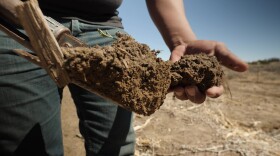-
The Southwest is at the forefront of climate change with issues ranging from longer and more intense fire seasons to water scarcity.In a new, hour-long special airing this Friday on New Mexico PBS, “Our Land” senior producer Laura Paskus will explore these impacts here in New Mexico and how the deep-rooted connections humans have with our land can pave the way to meaningful healing.
-
Land grant universities across the U.S. earn over $2.2B annually from oil and gas extraction on lands that were taken from Indigenous tribes. That includes New Mexico State University in Las Cruces. But, tribes almost never see a penny of it. That’s one of the recent findings of an investigation by environmental news outlet Grist.
-
Increased drought, reduced snowpack, and widespread wildfires are fundamentally changing the landscape of outdoor recreation as we know it.
-
This week, the federal government officially started a process to overhaul the rules governing a crucial river in the Southwest that provides 40 million people with drinking water. The Colorado River’s current rules are set to expire in 2026 and conservationists want a drastic change.
-
Elementary school teachers from across New Mexico can now apply for a program that aims to help kids understand the effects of climate change and promote real-world solutions.
-
On the heels of extreme weather events, like New Mexico’s devastating 2022 fire season, lawmakers are aiming to establish a public health program and climate resiliency fund to address health related issues in rural communities. This week, that bill has cleared its first hurdle in the Roundhouse.
-
New rules recently implemented by the state aimed at reducing methane emissions from the oil and gas industry are being challenged by an industry group. Environmental organizations are now stepping in to stop that appeal, claiming it would harm communities of color across the state.
-
The push away from fossil fuels and towards electric vehicles and home appliances is a challenge for rural New Mexico, which lacks the basic infrastructure and cash for these innovations.
-
Environmental organizations from all over the country are gathering in New York to celebrate the state’s annual Climate Week event alongside the United Nations General Assembly. One of them––the U.S. Climate Alliance––is made up of states committed to addressing climate change. It released a report showing New Mexico and the 23 other states under its umbrella are polluting less and saving more energy.
-
Over the past year, the University of New Mexico was awarded $1 million from the U.S. National Science Foundation to explore community resilience to natural disasters. So, scientists, PhD candidates, professors, and high school students decided to take this money and develop low-cost sensors to monitor post-wildfire flooding on pueblo land.
Play Live Radio
Next Up:
0:00
0:00
Available On Air Stations










